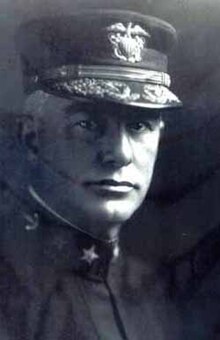William Ledyard Rodgers
| William Ledyard Rodgers | |
|---|---|
 |
|
| Born |
4 February 1860 Washington, D.C. |
| Died | 7 May 1944 (aged 84) Bethesda, Maryland |
| Buried at | Oak Hill Cemetery, Washington, D.C. |
| Allegiance |
|
| Service/branch |
|
| Years of service | 1878–1924 |
| Rank |
|
| Commands held | |
| Battles/wars | |
| Awards | Navy Cross |
| Relations |
|
| Other work |
|
William Ledyard Rodgers (February 4, 1860 – May 7, 1944) was a vice admiral of the United States Navy. His career included service in the Spanish–American War and World War I, and a tour as President of the Naval War College. Rodgers was also a noted historian on military and naval topics, particularly relating to ancient naval warfare.
He was the third generation in a well-known family of able naval officers. He was the son of Rear Admiral John Rodgers (1812–1882), who fought in the Second Seminole War (1839–1842) and the American Civil War (1861–1865), and the grandson of Commodore John Rodgers (1772–1838), who fought in the War of 1812 (1812–1814). Rodgers's own son, John Rodgers, born in 1881, also served as a U.S. Navy officer and was an early aviator, reaching the rank of commander before dying in a plane crash in 1926.
Born on 4 February 1860 in Washington, D.C., the son of John Rodgers (1812–1882) and Ann Elizabeth Hodge Rodgers (1823–1897), William Ledyard Rodgers entered the United States Naval Academy on 11 June 1874 and graduated in 1878. He served aboard the steamer USS Pensacola from 1878 to 1879 and at the United States Naval Observatory in Washington, D.C., from 1880 to 1881, and was promoted to midshipman on 4 June 1880. He served aboard the corvette USS Quinnebaug on the European Station from 1881 to 1884 and was promoted to ensign on 1 April 1882.
...
Wikipedia
